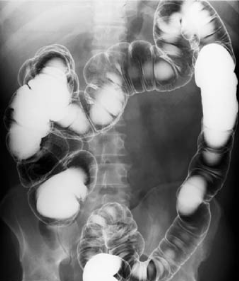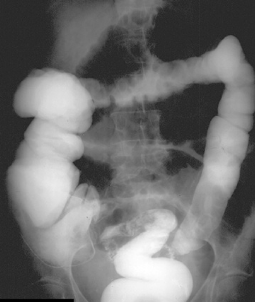PA Anatomy: Imaging Overview-Contrast |
||||||
To put contrast into the distal GI tract, it must be instilled using a tube placed in the rectum, a 'Barium enema'. While most studies of the upper and lower GI tract are done with Barium, if there is a clinical concern for perforation, a different type of contrast is used, which contains Iodine bonded to various complicated chemical compounds. This is because Barium cannot be reabsorbed from body cavities, so if it escapes through a performated bowel loop, it must be washed out surgically or via laparoscopy, and can form a site for infection. |
||||||||||
 |
||||||||||
This is a Barium enema, using both Barium and gas (double-contrast). The Barium pools in some loops of colon, but in others, it forms a thin white outline that you can see through, which helps in visualizing subtle abnormalities, or in seeing overlapping loops. This study is normal. |
||||||||||
This is an enema done with Iodine-based contrast (also called 'water soluable' contrast), which uses only the contrast material and no air. This is called a 'single-contrast' exam. The Iodine-based contrast is not as dense as Barium, and over time, it is absorbed from the colon, so it becomes even less dense. This study was done because of a concern for a colonic perforation, but it is normal. The sharpness and detail that can be seen is not as good as with a barium study. |
||||||||||
 |
||||||||||